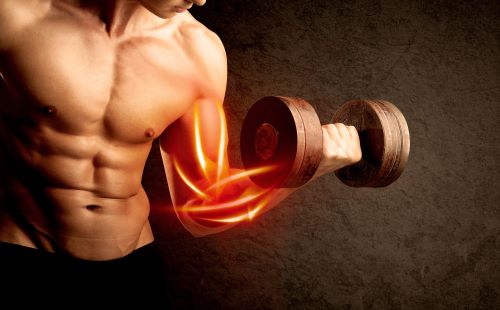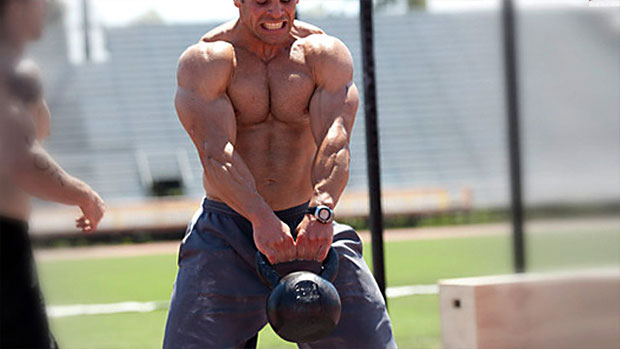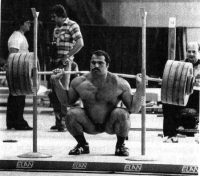If you have been in the health and fitness world for any amount of time, odds are that you’ve probably heard a lot of different (and potentially contradicting) information surrounding strength training and the best way to gain muscle.
The reality is that there is no one-size-fits-all situation. There are many different variables to your success. Things like, what your current fitness level is, what your goals are, or how often you exercise all play a large factor in your ultimate results.
For example, many people find that the periodization method to be highly effective while others may follow an undulating version instead, opting to vary their workouts.
Ultimately, the number of reps and sets, as well as how much weight is being used, all play vital roles in developing muscle growth. Research has proven that muscle hypertrophy is largely produced through continually increasing your reps, sets, and weight resistance. 1
So, if it’s true that there are many different ways to experience muscle growth, what is the “best” method available? In this guide, we’ll go over some key fitness principles that can be used in virtually any training exercise while still getting you amazing physical results.

Related: Best Supplement Stacks to Build Muscle
#1. INCREASE TARGETED MUSCLE GROUP TRAINING
While it is certainly important to give your muscles their respective time to rest and heal, repeated amounts of targeted muscle resistance training, alongside a high-protein diet, has been proven to increase muscle growth.
By working out your largest muscles around 2-3 times throughout the week, you will trigger an anabolic response in the body. This dramatically increases the amount of protein synthesis, thus developing larger muscles as a result.
One example of this was shown in a study where participants followed a regiment of 12 strength resistance sets over 31 minutes. The study showed that that the participants experienced excess post-exercise oxygen consumption (EPOC) for over 38 hours after working out. That is an incredibly long amount of time for an elevated metabolism. As a frame of reference, if you started training from 9 am to 10 am, your metabolism would still be in an elevated state until midnight THE FOLLOWING DAY! 2
Overall, one of the best methods of creating this elevated response is through frequent and intense full-body training in either a tri-set, circuit format, or superset. The reps should be at a large enough range to create lactic acid (mild soreness in the muscles) and ideally should be exercises that are noncompeting, resulting in less downtime between workout sessions.
Ideally, performing weighted squats, hinges, pushes, or pulls can dramatically increase metabolism compared to more isolated movements. The best number of reps seems to sit between 5 and 12, while higher amounts will also work for those with untrained or unconditioned bodies.

#2. EXPLOSIVE REP SPEED
The next method to increase muscle growth is with explosive lifts and fast rep speeds. By lifting as fast as possible with as much explosive force as possible, you can increase the number of muscle fibers recruited as the muscles repair themselves. In addition, you also can improve the nervous system, resulting in better performance during your workouts overall.
Now, if you are like many bodybuilders, especially those who have weight-trained over several years, you have probably used the slower and more controlled rep speed. And, while there is some truth to this regarding STRONGER muscles, it doesn’t necessarily mean LARGER muscles.
By lifting weights faster during the concentric phase, you can produce more muscle growth and an increase in muscle fiber recruitment. 3
This method is called the Dynamic Effort Method and it is also a popular way for athletes to build strength and explosive power.

#3. TAKE BREAKS IN-BETWEEN YOUR SETS
This next point is contested largely by fitness and bodybuilding/powerlifting beginners. Experts and experienced lifters, on the other hand, understand very well that one of the keys to lifting your best is TAKING BREAKS BETWEEN SETS.
For some reason, there is this idea that by taking a break you are losing your momentum. And, to be fair, it is “partially” true in the sense that you are allowing your body to slow down and catch its breath, thus ever so slightly reducing your metabolism speed. However, as we mentioned earlier, if you’re lifting properly, even if you give yourself a minute or two to rest your muscles, your metabolism is still in a highly elevated setting.
Resting is vitally important for a lot of reasons. Olympic lifters, as an example, give themselves considerable time between sets so that their nervous systems have a chance to fully recover. This is vitally important, as they are often lifting incredibly high amounts of weight in 1-4 rep sets. In these instances, they are focused more on increasing physical strength than building muscles.
Even if you aren’t an Olympic-level lifter, resting is still very important in between sets. This is primarily because you need to hold the proper amount of weight under tension for a sufficient amount of time to see muscle growth. In order to do this, you have to have enough ATP (Adenosine Triphosphate) readily available in the body.
ATP naturally depletes over the course of physical activity and must take time to replenish before you can access it again. By jumping the gun and not giving yourself enough time to fully recover, you will inevitably have worse and worse performing lifting sessions, ultimately resulting in you not holding the weight for enough time. Ironically enough, by trying to speed your way through a workout, you’re actually just setting yourself up for a waste of time.
The problem is that this often is taken too far in the opposite direction. Many college-level or older bodybuilders, as an example, will all but relax for 5-10+ minutes between sets. This isn’t what we’re talking about either.
The optimal method of resting muscles is to give yourself around 60 seconds of rest between sets before working out a different muscle group. For example, if you are doing dumbbell presses, after resting for a minute, do a 1-Arm bent-over row. This not only gives you around 2-3 minutes of resting the muscles in a specific area, but it also ensures you aren’t wasting valuable workout time just sitting around.
#4. OVERLOAD… PROGRESSIVELY
Arguably the most well-known method of reliably improving muscle growth and increasing muscle mass, by progressively increasing the amount of weight you are training against, you can continually create an anabolic response.
As it’s not realistic that you’ll be able to lift more and more each time you work out, what you can do instead is increase the number of reps or sets with a fixed weight. This means, if you are comfortable lifting 35 lb dumbells at 3 sets of 5, rather than shoot for 45 lb dumbells, do 5 sets of 5 or 3 sets of 8. This allows you to push yourself for that anabolic response even without increasing the actual amount of weight being used.

Related: Best Creatine for Muscle Building, On a Budget, Best Tasting and More…
#5. CAPITALIZE ON YOUR BIG MOVEMENTS
If you expect to increase your muscle growth, you’re going to need to perform compound movements. While resistance bands, isolated work on the machines, or small dumbells may be good to start, they just aren’t going to be enough if you are looking for that anabolic response we talked about earlier.
To get that, you are going to need to perform multi-joint movements. Exercises like deadlifts, squats, presses, and pulls are going to be your foundation for seeing the most results.

#6. ENGAGE THE WHOLE BODY IN STRENGTH TRAINING
Now, when I say “whole body” I’m not talking about CrossFit. CrossFit is a great exercise method and can give some great results. For building large muscles, however, it’s not the best way to go.
Whole-body, or full-body, strength training is where your workout session results in you focusing on, well, the whole body. These are great for average people who simply aren’t interested in devoting large portions of their week to the gym. Rather than investing 5-6 days of the week to working out, you can instead save time by getting much of the same benefit through 3 days of a full-body workout.
In addition to the time benefit, full-body workouts also work several muscle groups in a single session. This increases HGH, or human growth hormone, at a much faster rate when compared to traditional bodybuilders. It also is great for improving one’s metabolism due to the increased physiological and neural demand on the body.
If you are someone looking to lose body fat and improve overall fitness, spending a large amount of time performing full-body strength workouts will result in you getting the most benefit in the fastest amount of time with the least amount of time invested on your end. Conversely, for bodybuilders and those who are exclusively looking to gain greater muscle mass, switching up from heavy weight lifting to full-body strength training every few weeks will allow you many of the HGH benefits and metabolism increases that you’d otherwise miss out on.
CONCLUSION
As I said in the beginning, there are many different methods and exercises you can use to increase muscle growth and there is no “perfect” way that works well for everyone. Where you are in your workout journey, what you are looking for, and what you are comfortable doing all play a big factor in what program will work best for you. Still, there are some tried and true principles that, if followed, can dramatically improve the quality of your workout no matter what it is.
By following these 6 Muscle Growth Workout Tips, you can improve your physical body and put yourself on the right path to gaining the muscular physique you’ve always wanted.
References:
- https://pubmed.ncbi.nlm.nih.gov/28834797/
- https://pubmed.ncbi.nlm.nih.gov/11882927/
- https://journals.physiology.org/doi/full/10.1152/japplphysiol.01027.2004

Ryan is a former college wrestler and lifelong fitness fanatic with over 25 years in the industry. He’s run half marathons, tackled mud runs, placed in body transformation contests, and coached everything from wrestling to girls’ soccer.
Along the way, he’s tested hundreds of supplements and built a deep well of supplement knowledge. His work has appeared in Muscle & Strength, Testosterone Junkie, The Sport Review, and more. Today, he’s the editor-in-chief of this site, still training hard and helping others reach their goals. Connect with him on LinkedIn below.








